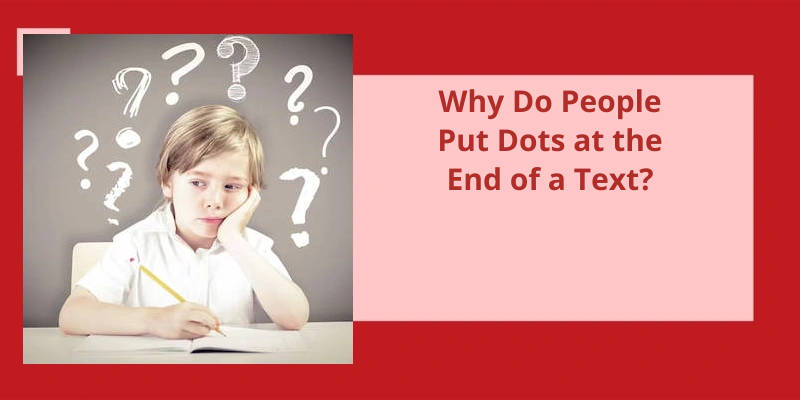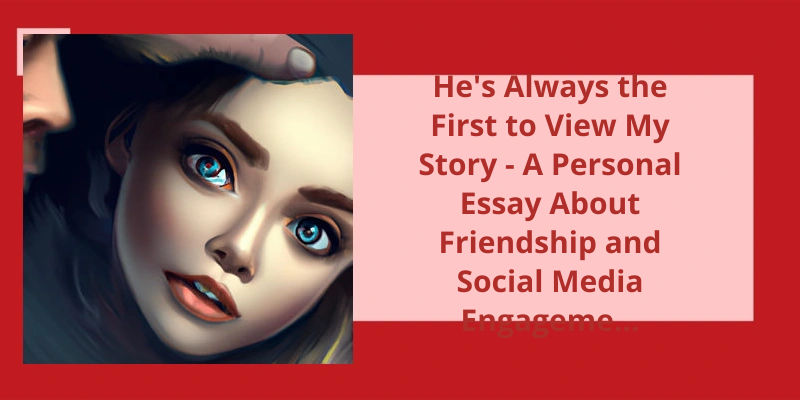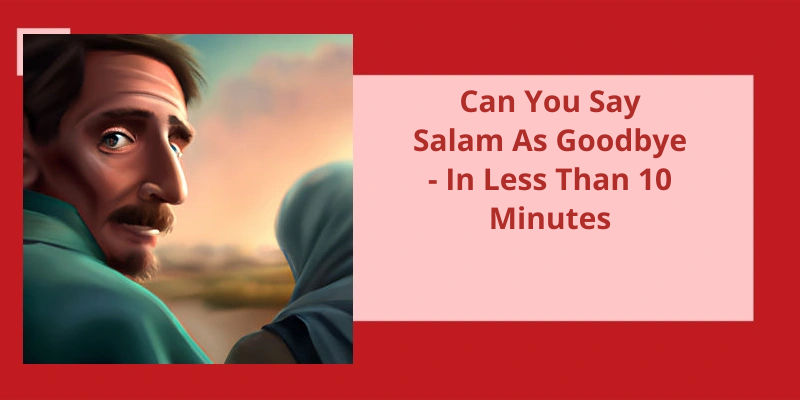Now let's delve into the fascinating topic of why people put dots at the end of a text. These seemingly innocuous ellipsis points hold more significance than meets the eye. Often consisting of three or occasionally four periods, they serve two distinct purposes – indicating the omission of text in a quotation and signifying a pause or trailing off in speech or thought. As such, they’ve become a prevalent feature in written communication, adding nuance, suspense, and even emotional undertones to our messages. But why do individuals choose to incorporate these dots at the end of their texts, and what do they truly convey? To uncover the answers, we must explore the psychological, linguistic, and cultural aspects that underpin this intriguing phenomenon. With a thorough examination, we can unravel the mysteries behind this prevalent punctuation choice and gain a deeper understanding of it’s impact on our interpretations of written language. So, let’s embark on this exploration into the world of ellipsis points and uncover the reasons behind why people put dots at the end of a text.
What Does Ellipses Mean in Texting?
The use of ellipsis in texting has become a common practice among many individuals. It serves as a way to convey a variety of meanings and emotions without explicitly stating them. When someone uses ellipses in their text messages, it often indicates a pause or hesitation in their thoughts. It can also suggest that there’s more to be said, leaving the conversation open-ended.
One of the reasons people put dots at the end of a text is to create a sense of suspense or mystery. By leaving a sentence unfinished with an ellipsis, the sender is inviting the recipient to fill in the gaps and continue the conversation. This can be a playful way of engaging the other person and keeping them guessing about what’ll come next.
By trailing off with dots, the sender implies that they aren’t entirely sure about their statement or are leaving room for interpretation. This can be a way of softening the impact of a potentially sensitive topic or expressing a degree of vulnerability.
Whether it’s to create suspense, express hesitation, or invite further discussion, the dot dot dot has become a powerful element in digital communication.
The vertical ellipsis, consisting of three vertical dots, is a commonly used symbol to represent omission or missing information. Similar to the traditional ellipsis (..), it suggests that content or actions have been left out intentionally. When utilized in digital interfaces or menus, these three dots typically signify hidden or additional options that can be accessed by clicking on or interacting with them. However, it’s important to note that the use of three vertical dots can vary depending on the context and platform.
What Does 3 Vertical Dots Mean?
The three vertical dots, known as a vertical ellipsis, hold significant meaning in the realm of digital communication. Similar to it’s counterpart, the ordinary ellipsis (.), it implies the omission of content. When employed at the end of a text, these dots evoke a sense of trailing off or unfinished thoughts. The intentional omission of words or ideas sparks intrigue, prompting the recipient to ponder the unsaid aspects and inviting them to fill in the missing gaps.
This practice has become increasingly prevalent in various forms of online communication, such as messaging platforms and social media. It’s evolved into a stylistic choice, often employed to convey a sense of mystery, create suspense, or engage the recipients curiosity. The dots raise questions, leaving the reader craving more context or information. By strategically placing these dots at the end of a message, individuals can initiate further conversation or ignite a sense of anticipation.
Moreover, the use of the vertical ellipsis resonates with the fast-paced nature of digital communication. In the age of rapid-fire messaging, these dots offer a swift and concise way to suspend the conversation momentarily. They signify a pause or interruption, giving the sender time to gather their thoughts or perhaps indicate the messages open-endedness, leaving room for the recipient to respond.
It’s a linguistic phenomenon that’s puzzled many: why do older people use ellipses so frequently? The answer lies in their tendency to let thoughts trail off in a casual manner, marking the end with three dots. Younger generations, on the other hand, are more accustomed to using line breaks for this purpose, a reflection of their familiarity with vertically scrolling digital text.
Why Do Old People Use Ellipses All the Time?
Have you ever noticed that older people tend to use ellipses all the time? It’s a peculiar phenomenon that’s intrigued many. But why do they do it? Well, it’s all about communication habits and the way different generations interact with text.
Older individuals, who grew up in a time when typewriters and handwritten letters were the norm, tend to use the three-dot ellipsis as a way to let a thought trail off in a casual way. It’s almost as if they’re pausing for a moment, allowing their words to fade into the background. For them, the ellipsis is a natural way to convey a sense of informality and ease in their writing.
On the other hand, younger people, who’re more accustomed to digitally scrolling through text, have adopted a different approach. Instead of using ellipses, they opt for a line break to create a similar effect. With the vertical nature of digital platforms, a line break serves as a visual cue that their thought is coming to an end. It’s a way for them to mimic the natural pause that older folks achieve with an ellipsis.
The two dot ellipsis, also known as the ellipsis lite, serves as a punctuation mark to indicate a brief pause in writing. Unlike the traditional three dot ellipsis that denotes omission, the two dots are used for a shorter pause, imparting a different meaning to the reader. Let’s explore the usage and significance of this lesser-known punctuation in writing.
What Are the 2 Dots After a Word?
The two dot ellipsis, also known as a double dot or ellipsis lite, is a form of punctuation that isn’t as well known or widely used as it’s three dot counterpart. Unlike the three dot ellipsis, which is commonly used to indicate the omission of words in a text or to create suspense, the two dot ellipsis serves a slightly different purpose. It’s primarily used to indicate a brief pause in speech or writing, often a shorter pause than what would be indicated by a full three dot ellipsis.
It can be used to create a more fluid and concise flow of language, conveying a sense of hesitation or a moment of reflection.
Many style guides and grammar experts may discourage it’s use, or may be unfamiliar with it’s intended meaning. As a result, it’s important to use the two dot ellipsis with caution, and to consider your audience and context before incorporating it into your writing.
However, it’s important to be aware that not everyone may be familiar with it’s intended meaning, so it should be used with caution and consideration of your audience.
In addition to German, umlauts can also be found in other languages such as Swedish and Finnish. The presence of these two dots changes the sound of the vowel, giving it a distinct pronunciation. Therefore, understanding the purpose and function of the umlaut is crucial when learning and speaking these languages.
What Are 2 Dots Over a Vowel Called?
The umlaut is a diacritic mark that consists of two dots placed above a vowel. In German, the umlaut is particularly common and is often used to modify the suggested pronunciation of the letter “a.”. When the letter “a” has two dots above it (Ä), it’s pronounced as a combination of the sounds /e/ and /a/. This sound is similar to the “e” in the English word “bed.”
The purpose of using umlauts is to indicate a different pronunciation for a specific vowel. This modification helps clarify the pronunciation of words and enhances the accuracy of spoken and written German.
Conclusion
However, the use of ellipsis points in text messages or casual conversations has taken on a new meaning. It’s become a way for people to convey various emotions, such as uncertainty, hesitation, or suspense. By ending a text with dots, individuals can create a sense of anticipation or leave room for the other person to continue the conversation. Additionally, the use of ellipsis points can add a certain dramatic effect to a message, making it more intriguing or mysterious.






